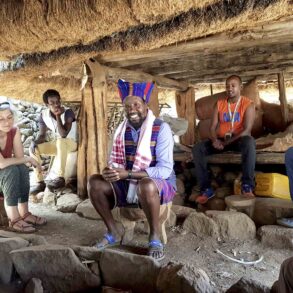The Spacecraft JUICE has been launched successfully by the European Space Agency (ESA) and sent on its journey to Jupiter and its mysterious satellite, Ganymede. The information it will transmit in ten years’ time could change our worldview.
Twice before the observation of Jupiter’s moons changed the image of the world as seen from Earth. The first time was in 1610, when Italian astronomer Galileo Galilei, holding a first simple telescope from the Netherlands in hand, saw the moon and the planets in 20x magnification through cloudy lenses. «On January 7 of this year 1610, at the first hour of the following day, as I was gazing at the stars through the telescope, Jupiter revealed itself to me; and since I had built a truly excellent instrument, I discovered three small, but very bright stars close to the planet.» Galileo had discovered three of Jupiter’s bright moons, soon making out a fourth one, as he described in his treatise ‹Sidereal Messenger›. He had found further evidence that the heavenly bodies are not revolving around the earth. As Leonardo da Vinci, the artist who dreamt of helicopters, or Johannes Kepler, who wondered how to measure the volume of bulbous wine barrels, Galileo also thought along practical lines: Io, the Jupiter moon closest to the Sun, takes 42.5 hours to orbit the planet. This is the rhythm of its reappearance behind the disc of Jupiter. Amateur astronomers today also like to point their telescopes to the left side of the Jupiter disc when moon Io is due to appear from behind the planet as a small speck of light. Galileo was convinced that this observation could solve the longitude problem in navigation. While it is easy to determine the geographical latitude using the altitude of the North Star, a particular time designation is required for the geographical longitude, in other words for a ship’s east-west position. Ships did not have reliable clocks in Galileo’s time, which meant they often drifted hundreds of nautical miles off course. Giovanni Cassini, another astronomer and contemporary of Galileo, then worked out timetables charting the eclipses of the Jupiter moons.
A Slow Cosmic Clock
Surprisingly, the moons did not adhere to these calculations. When Jupiter traveled at its greatest distance from Earth on the other side of the Sun, the cosmic clock of Moon Io was 17 minutes slow compared to the time when the Earth was close to Jupiter. The astronomer Ole Römer found the explanation: When Jupiter is furthest from the earth, Io’s light needs to travel 300 million kilometers further. Being 17 minutes (= 1,000 seconds) ‹slow› means that Io’s light needs 1000 seconds to cover the greater distance. Such a simple calculation: 300,000,000 kilometers divided by 1000 seconds equals 300,000 kilometers per second. Römer worked out the speed of light from the orbit of the moon Io! Light, which is in all religions the archetypal image of meaning and eternity, is subject to time! This insight opened the door to the modern physical worldview. For the second time, humanity’s earthly-cosmic self-concept was shaken due to the moons of Jupiter, named ‹Galilean moons› in honor of their discoverer.
Black Ocean
On April 17, the probe JUICE (Jupiter’s Icy Moon Explorer) was launched and maybe it will for a third time correct our worldview as it explores the moons of Jupiter. The Jovian world is busting planetary standards in many ways. Jupiter is more massive than all other planets combined, which means that its barycenter with the Sun lies beyond the Sun’s surface; and this giant planet is orbited by more than 90 moons. Not only its size is difficult to fathom but also its movement: this giant takes nine hours to rotate and, like the Sun’s, its equator rotates five minutes faster than its polar regions, causing continuous oscillation. The moons discovered by Galileo are no less spectacular. While Earth’s moon emanates total calm, the moons of Jupiter are quite active. Io is the only moon in the planetary system that has volcanism, and Ganymede, the largest moon in the planetary system, features auroras. It has its own magnetic field, with an iron core at its center. Computer simulations suggest that the auroras can only be explained by a huge interior salty ocean. Pictures taken by previous probes such as Voyager and Juno already indicated this, because they showed cracks in the icy shell of Ganymede and Europa, pointing to the presence of internal currents. Astronomers assume a huge 100-kilometer ocean beneath Ganymede’s 100-kilometer-thick crust of ice. This would mean that there is much more water on Ganymede than there is on Earth.
A Long Journey
Spacecraft JUICE has been launched successfully. It unfolded its 85 square meter solar panel and is now on its way to the outer planetary system. It will receive momentum for this journey first from Earth, then from Venus, and then again from Earth, before taking gravity assists from Mars to have enough energy to reach Jupiter in July 2031. What a triumph of calculation and computer technology! For more than five years the spacecraft will travel through the movement system of the Jupiter moons, meeting these four largest satellites one after the other in complex elliptic orbital maneuvers. In September 2034 it is due to descend on Ganymede in order to collect data from its atmosphere and surface. According to ESA, it is JUICE’s astrobiological mission to gain new insights into the origin of life. Maybe it will be as with the two previous lessons learned from the observation of the Jupiter moons: the change from the geocentric to the heliocentric worldview, from eternal to finite light. The question will probably not be how life arrived in a dead world but how death arrived in a living world.
Translation Margot M. Saar
Image Jupiter’s moon Ganymede, imaged by the Juno spacecraft in June 2021. Photo: NASA, CC-BY 2.0














W. Held’s article about the history of Jupiter discoveries is very interesting. This reminds me of my question about how Rudof Steiner’s Planets relate to the ones that are now being investigated. Is the RS Moon the same one where men landed half a century ago? Is RS Mars occupied by Buddha and Christian Rosenkreutz, the same one being explored by earthly robots? Personally I find it difficult to hold both pictures in a congruent whole. Each view seems to negate the other.
Hi, personally, I think that the opposition of these two pictures you experience is only apparent. It seems to relate to the opposition of purely material science to spiritual science in general. Rudolf Steiner describes the planetary (including Moon and Sun) spheres in their both aspects – spiritual and material. The latter being formed by the opposition of certain spiritual beings lacking behind in evolution, creating, as a result, sort of a seal or signature, of the spiritual underlying reality carved in matter.
In conclusion, as long as one perceives matter and spirit separately, the tension is always there and meaning is ever eluding. The key to understanding is overcoming this duality and working out truly meaningful ideas and concepts.